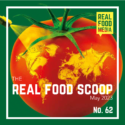by Anna Lappé
If you made National Geographic collages of the basic four food groups — meat, dairy, grains and fruits and vegetables — in elementary school as I did, you have the federal government’s dietary guidelines to thank. Every five years, the government reviews these recommendations and releases new advice to eaters. The implications are huge: The guidelines direct billions of dollars in government food and nutrition programs, from school food to funding for the Women, Infants and Children program. What’s more, they inform how millions of Americans decide what is healthy for themselves and their families — influencing billions of dollars in food purchases.
Last year the government’s nonpartisan Dietary Guidelines Advisory Committee made some unprecedented recommendations. Among other things, it suggested it was time to break from past guidelines and make clear that Americans should reduce consumption of red and processed meats and added sugars, especially sugar-sweetened beverages.
The committee also argued that the guidelines should take sustainability into account. Healthy eating, after all, means ensuring that we can feed ourselves and our children healthy food for decades to come. To that end, the committee wrote that “a diet higher in plant-based foods, such as vegetables, fruits, whole grains, legumes, nuts and seeds, and lower in calories and animal-based foods is more health promoting and is associated with less environmental impact than is the current U.S. diet.”
Unfortunately, the final guidelines, released last week, backpedaled on many of these common-sense recommendations. The reason is simple: The food industry — especially meat and beverage companies and trade groups — lobbied heavily against the committee’s recommendations. According to Bloomberg, four-fifths of the 60 groups that lobbied on the guidelines represented food corporations, industry groups or farmers. While Barack Obama’s administration presented the final guidelines as the best distillation of nutrition science, the reality is that they have been distorted by industry influence.
For instance, while the recommendation to reduce added sugars stuck, the emphasis on soda — one of the main sources of such sugars — was downplayed. Dr. Lawrence Gostin, the director of the World Health Organization (WHO) Collaborating Center on Public Health Law, said on Democracy Now that the biggest beverage companies “put a lot of pressure” on government officials to change the language.
The recommendation to reduce meat consumption was also distorted. The final guidelines suggested limiting such consumption only for teenage boys and men, and even this recommendation was buried in the final report. Noticeably absent from the guidelines was a strong recommendation for reducing red and processed meats, even though the science is clear about their links to serious illness.
As my colleague Kari Hamerschlag from Friends of the Earth said in a statement, “Despite clear evidence that high red meat consumption is linked to cancer and threatens future food security because of its huge resource demands, the 2015 guidelines failed to make a specific portion size recommendation for red meat,” as in the 2010 version. While the WHO recommends significantly limiting intake of processed meats because of the associated increased cancer risk, the guidelines are fuzzy on this message. In fact, buried in the guidelines is the suggestion that eating processed meat is fine as long as it is in quantities that fall below fat and salt limits. Nowhere is there a reference to the WHO’s findings linking processed meat consumption and certain cancers.
As for the sustainability language, that was taken off the table months ago when Department of Agriculture Secretary Tom Vilsack declared it beyond the scope of the dietary guidelines. (Though the final recommendations include physical activity — decidedly not a dietary recommendation). Dr. David Katz, the director of Yale University’s Prevention Research Center, expressed his disappointment, saying in a statement, “If we ignore sustainability, it’s as if we are saying we don’t care whether what is good to eat and drink is still here as a choice for our children and grandchildren. What a deplorable, unconscionable position that is to take.”
The final language frustrated many observers. Groups such as My Plate, My Planet (which brought together environmental and health organizations and individuals in defense of the advisory committee’s recommendations), Friends of the Earth and the Johns Hopkins Center for a Livable Future helped mobilize ordinary Americans, public health officials and doctors to express their support during the public comment period. An unprecedented 150,000 petitions and 29,000 public comments were submitted. In addition, more than 700 health professionals submitted a letter in support of the committee’s report and a resolution from the U.S. Conference of Mayors did so as well.
Despite this public expression of support, the U.S. food industry lobbied heavily to shape the finalized guidelines. The meat industry, for one, was “pleased with the fare served up in the [guidelines].”
This isn’t just industry playing politics with our plate; it’s industry being complicit in the loss of life and limb of millions of Americans. About half of Americans have one or more preventable chronic diseases relating to poor diet or physical inactivity, including hypertension, diabetes and diet-related cancers, according to the Centers for Disease Control and Prevention. Today, thanks in large part to added sugars, especially in soda, 29 million Americans suffer from diabetes; one-third of African-Americans are predicted to be afflicted by the condition in their lifetime. In 2010, 73,000 Americans had a lower limb amputated as a result of diabetes.
From 1956 until 1992, the USDA dietary guidelines recommended that we eat from those basic four food groups. What those recommendations obfuscated was that there are ample sources of protein besides meat and ample alternate sources of calcium besides dairy. Yet those food groups stuck around for more than three decades because of pressure from the dairy and meat industries, not because of sound science.
We’ve finally done away with these false classifications. Today’s recommendations talk about dietary patterns instead, even introducing a vegetarian dietary pattern as a healthy choice. We’ve also enjoyed success in pushing for recommendations to reduce added sugars. Yes, the guidelines may be a poor representation of the sound recommendations of the dietary guidelines committee, but they are a step forward.
Originally published in Al Jazeera America




